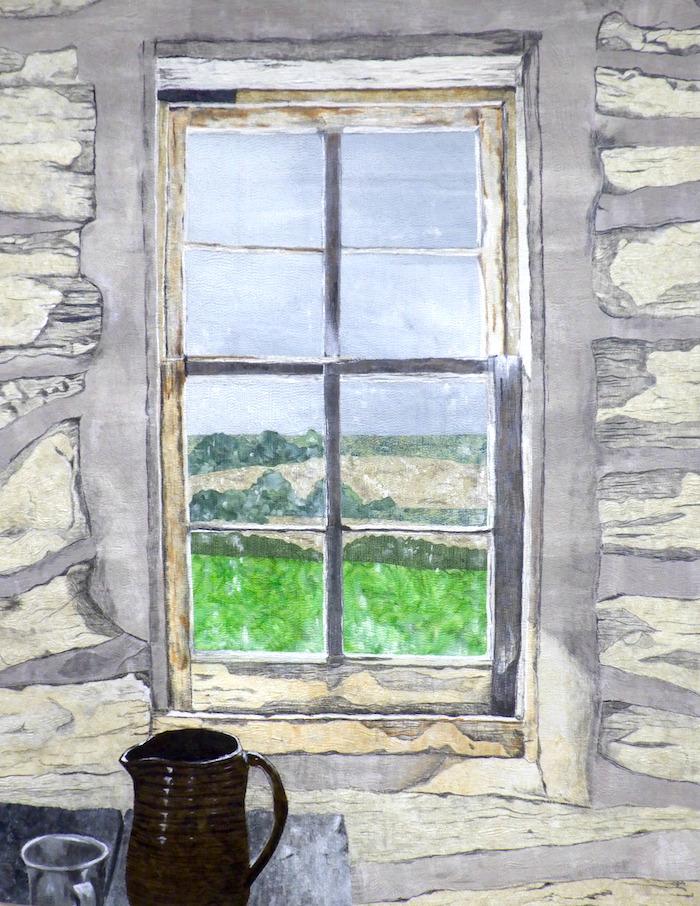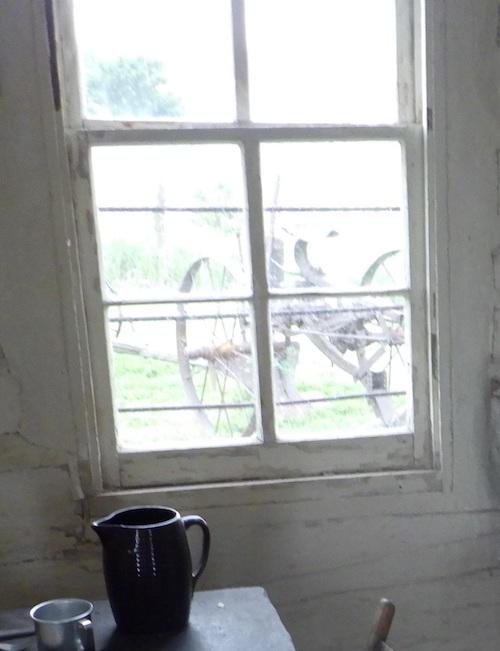
A Shenandoah National Park scene captured by Nancy Hershberger/Kurt Repanshek
HOMESTEAD NATIONAL HISTORICAL PARK -- Though Nancy Hershberger might be dismissed by "traditional" quilters, her patchwork designs capture a setting deserving a spot in an art gallery, or a wall in your home.
True, her quilts won't cover your bed or keep you physically warm on a cold night. But they likely will bring a knowing smile to your face and possibly remind you of a place in time from your wanderings through the National Park System.
"I don't think it's so unique, because there is a whole world of art quilters out there who do their own thing," Hershberger explained during a break in her artist-in-residence role at Homestead National Historical Park in Beatrice, Nebraska. "What I do is fuse. I fuse fabric onto the batting. And then I use inks, and sometimes paints, but on this one in particular inks, just to help boost the illusion of glass or woodgrain."

A "quilt" depicting a scene from the Palmer-Epard Cabin at Homestead National Historical Park/Kurt Repanshek photo
We were standing in front of a 35-inch by 44-inch "quilt" she had made that captures a view from the Palmer-Epard Cabin at the Heritage Center in the national park that recounts America's history of homesteaders. It's as if you were gazing out of the cabin from the window. Just inside the window is a table with a brown pitcher and silver cup on it. Hershberger nailed the real thing.
"So, you are transposing that photograph through your artistic talents into a quilt of sorts?" I asked.
"That's right. Yes, it is really a quilt. It's just not made to put on your bed. It's made to hang on the wall," she explained. "And to be viewed from a slight distance.
"But you know what's really interesting? When you say it's a quilt, when the minute you say it's a quilt, people will be standing out here and they immediately walk up inches from the surface, and they want to touch it, because they want to, they want to feel the texture. The actual texture. People get close to quilts. Whereas if it were really a painting, they would step back. I just thought that was interesting."
Hershberger is somewhat new to both "quilting" and to national parks, at least when it comes to capturing park settings in fabrics, paints, and stitching that are to be given room next to a water color or other painting in your home. The 58-year-old from Breezewood, Pennsylvania, didn't get a serious start with needles, thread, and fabrics until she closed the books on her 20-year construction industry career in 2012. She had been an office manager.
"The industry left me behind in 2012. It was OK. I was a little stressed out, maybe a lot," she said. "Quilting was my therapy. It still is. In 2012 I was learning the skills, making traditional pieced quilts. It didn’t take long before I got restless and took a few classes experimenting with different techniques and tools. I made my first art quilt in 2014 and never looked back."
That initial foray into traditional quilting opened a doorway that transformed quilting for bedding into artistic quilting, and that approach to textiles brought Hershberger into the park system.
"In 2018, I applied to Manassas National Battlefield Park [for the artist-in-residence role]. I was hooked!," Hershberger said. "Imagine being given time to live and work inside a national park, a place of endless inspiration. The hardest part is trying to decide what to do first."
When the artist finds a setting she thinks would make a good quilt, she takes a photo to use as a reference model. She then cuts fabrics into various sizes to reflect a portion of the photo. These are fused onto the batting -- she uses silk batting for its lightness -- with a glue, while paints and dyes are utilized to get the desired coloring, and then she can stitch through the layers -- top, batting, and backing -- to enhance the effect.
The glue, explained Hershberger, is "made for fabric. And it's very, very light. And you can stitch through it very easily."

The window setting in the Palmer cabin/Kurt Repanshek
"To fill in the details, there are a couple of things that I really love to do," she continued. "And that is to use the inks to push that illusion of woodgrain or this plaster that's, you know, falling off. And then again, thread, you can do so much with thread, you can use it as part of the composition, as opposed to just holding the layers together. This is doing more than holding the layers together. This becomes part of the piece."
Different projects can take different amounts of time to complete.
"Since I am given the gift of time at a national park, I have the time to focus on a project from start to finish," said Hershberger. "'The Homestead' took 88 hours. That said, it took years of study to get to those 88 hours. Most of my work takes a bit longer. Some quilts take 60 hours or more just to quilt."
Choosing a setting in a park can also take time. Walking across meadows or through forests, heading down trails, exploring historical aspects, they all can lend inspiration. At Homestead, the artist had a stretch of tallgrass prairie, the uniquely shaped Heritage Center (it was inspired by a plow), the Freeman School, and the Palmer-Epard Cabin, which was built in 1867, to choose from.
The view from the cabin and the possibilities really spoke to Hershberger.
"The Palmer cabin was built in the late 1800s. It's always a log cabin," she said. "And so you've got all these different textures to create so to speak, as well as the plaster chinking, and then it's this gorgeous window looking out across the landscape. And so you've got the the grays and the browns and the buffs are the plaster colors of the interior of the cabin. And then you're looking out across this, this bucolic landscape of green pasture I guess, or fields, and then the forests and then the light blue sky. And of course in the foreground inside the cabin you've got a nice brown pitcher in a silver cup."
She admitted though, that she didn't leave Homestead near the end of June devoid of projects from that park.

Nancy Hershberger at work in 2021 during a residency at Great Smoky Mountains National Park/Cynthia Zacheis
"Every park has inspired not one or two quilts, but several series of quilts. Homestead was no different," Hershberger said. "Yes, it was difficult to decide which to do first. The reason I chose the Palmer Cabin interior is because there was something about looking from the weathered past into the unclear present. The window was cloudy enough to glaze over detail. The wall’s texture (the past) catches your eye first, guiding your eye to move to the window. You can see the plowed fields, the grasses, shrubs, but there is nothing to focus on and your eye moves back to those weathered walls, the pitcher, the metal cup. It is a simple composition, that for me, speaks volumes.
"I have lots of photos of the prairie fields, trees, and many photos of a thistle in full bloom," she added. "It is absolutely beautiful. The maintenance crew mowed around it. It is not an invasive weed but a native plant to that area. Beautiful! That is probably my next quilt."
Hersberger's quilting travels have taken her from Manassas National Battlefield Park, Great Smoky Mountains National Park, and Shenandoah National Park to Stones River National Battlefield, Fort Union National Monument, Homestead National Historical Park and soon to Indiana Dunes National Park.
During her residency at Great Smoky Mountains in 2021, the park's creeks, streams and waterfalls beckoned.
"The park revealed its most inspiring element one quiet moment while I was driving to Clingmans Dome," the artist wrote in an essay for Friends of the Smokies. "Water danced and flowed along every twist and turn in the road. The water gurgled and flowed and sparkled. The water rested in small pools so clear you could count the pebbles on the bottom. That water changed the direction of my work."
One of her largest works so far -- 58 inches wide by 64 inches long -- captures a cool, wet corner of Shenandoah.
"It was inspired by the Dark Hollow Falls," she said. "I was there last year. Every park has its own story. When I went there I went there on a mission to find the water at Shenandoah because Shenandoah is really all about the vistas, right?
"Dark Hollow Falls isn't far from the road, but it's a 500-foot descent," said the artist. "That's pretty steep, you know, but it's worth every aching muscle and joint to get there. Because it is so beautiful the way it cascades toward you from a distance. It's just just gorgeous."
Traveler footnote: You can follow Hershberger and her work on Facebook.

Add comment